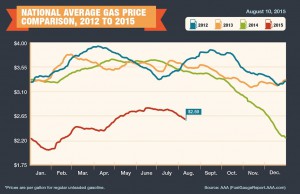With the end of the summer driving season looming, the average price for regular unleaded gasoline has fallen for 26 consecutive days and now averages $2.59 per gallon across the U.S., according to AAA’s latest survey data.
The current slide is the longest streak of consecutive declines since January. AAA estimates drivers are saving six cents per gallon week-over-week and 17 cents per gallon month-over-month.
West Texas Intermediate, the domestic benchmark for crude oil and also known as WTI, has reached its lowest price since March 2015, and market fundamentals point to prices moving lower in the near term as the oversupply of crude continues to characterize the oil market, and according to the latest report from the U.S. Energy Information Administration, refinery utilization rates are running at record highs.
The monthly average price of crude oil currently accounts for approximately 40% of the price consumers pay at the pump, and with WTI posting its sixth consecutive week of losses, pump prices are likely to post notable declines leading up to the Labor Day holiday.
California, at $3.58 per gallon, remains the nation’s most expensive retail market for gasoline, but prices in that state have fallen for 14 consecutive days for a total savings of 23 cents per gallon. Motorists in South Carolina are paying the nation’s lowest prices, $2.20, at the pump, but prices also have tumbled in the Midwest as prices have fallen between 7 cents and cents per gallon in states such as Iowa, Minnesota, Michigan and Indiana.
The average price at the pump has moved lower in 48 states and Washington, D.C. month-over-month. Motorists in 35 states and Washington, D.C. have seen prices move lower by double-digit increments over this same period, with the largest drops in price seen in Michigan, Indiana and Kentucky.
Yearly comparisons continue to reflect significant discounts in the average price for retail gasoline. The vast majority of drivers (47 states and Washington, D.C) are saving 75 cents or more at the pump, and retail averages are down by $1 or more in seven states over this same period. The largest year-over-year discounts in the price at the pump are seen in Indiana (-$1.13), Michigan (-$1.10) and Hawaii (-$1.10).
(Gas-powered cars may become the exception rather than the rule in California. For more, Click Here.)
Expectations that the global oil market will remain oversupplied in the near term are keeping downward pressure on the price of crude. The Chinese economy continues to show signs of weakness, which increases concerns that this expected driver of global consumption may not be poised to help counter the market’s oversupply.
Domestic focus has shifted to the potential for a glut in gasoline due to strong refinery runs and the potential for demand to drop as the summer-driving season concludes. In addition, U.S. crude oil rig counts have added 32 rigs over the last six weeks. Combined with record refinery runs, it is increasingly likely that excess supply will characterize the domestic market and keep downward pressure as West Texas crude settled down 79 cents at $43.87 per barrel, which was a five-month low.
(Click Here for details about GM’s victims compensation fund.)
Strong demand in the U.S., coupled with refinery problems, have kept gas prices higher than would otherwise be expected based on the cost of crude oil. Gasoline demand in July is up about 6% compared to a year ago, based on the latest four-week averages by the EIA. Strong gasoline demand can lead to tight supplies, especially if refineries are experiencing problems.
The average price of diesel is now only seven cents per gallon more than gasoline today. The difference between gasoline and diesel reached its most narrow point since 2009 in July. In January, the average price of diesel was 90 cents more expensive per gallon than gasoline.
(To see more about the college carshare program from Nissan and Enterprise, Click Here.)
Gas prices should continue dropping to catch up with the recent decline in the cost of crude oil. Gas prices could drop even further if oil continues to fall and gasoline supplies grow larger this month.


This does not apply to the Great Lakes States. On Aug. 11, the price jumped from $2.21 to $2.69 and on Aug. 12, it jumped to $2.99 in west Michigan. Gas Buddy says it is due to a ruptured pipeline at an Indiana refinery and the price may reach $3.39 before it is done. Gas Buddy went on to say, after repairs he expects the price to come back down and eventually dip below $2.00 per gallon.
The oil industry Cabal tells the media what it wants them to disseminate. No one every checks the accuracy of the info. and it’s often impossible to get straight info. from anyone in a Cabal.
Every year there is a refinery fire or maintenance shut down for some reason that is used to justify instant Windfall profits from price gouging. How many gas stations do you see that are closed due to no gas in their storage tanks? The answer is ZERO.
The pump price is not likely to be $2/gal. ever again unless the refineries have more crude than storage facilities. In the last 10 years the oil companies have increased the U.S. storage capacity by over 35% so they can ride out the gluts that occur when OPEC is shipping more than needed to meet demand.
Same here in NW boonies 45 miles outside Chi-town; prices jumped from $2.45 to $2.69 last week, then down to $2.60 but yesterday to $3.19 ~ $3.39. In the city it is higher.
This seems to coincide every time this site and others state fuel prices have drop, so please, do me a favor
STOP REPORTING DECREASE IN FUEL PRICES!!! LOL
Do you think someone might be manipulating pump prices? I’ll bet there was no rationing or limits on how much fuel you could buy at $3+ a gallon.